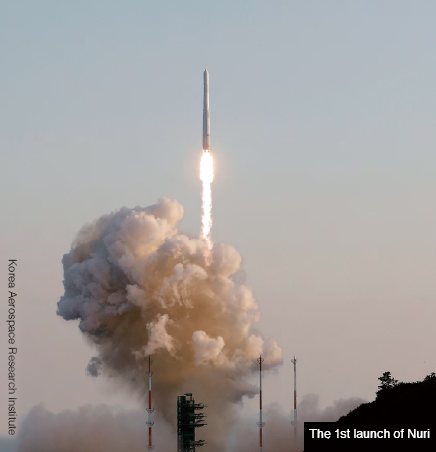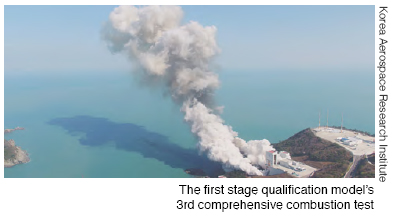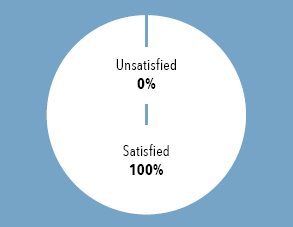The first launch of Nuri, the Korea Space Launch Vehicle-II (KSLV-2), was held at the Naro Space Center in Goheung on October 21, 2021, at 5 p.m. All of Nuri’s flight procedures, namely the first stage, fairing, second stage, and dummy satellite separation, were successfully completed. However, although the dummy satellite reached the 700km targeted apogee, the third stage’s engine shut down about 46 seconds earlier than planned. Thus, the dummy satellite could not achieve the speed of the orbit and crashed into the sea near Australia.

Koreans have various opinions on this Nuri Rocket launch. Some have called it a “half-success” because the last step of putting the dummy satellite into the target orbit failed. Others say it was “more than a 90 percent success” because all other launch processes were successful. This article covers the current state of the Korean space industry as well as people’s views on the Nuri Rocket launch.
The First Launch of Nuri
The name “Nuri” (the world, in English) was selected through a naming contest. It aims to “open a new world in the universe.” Nuri, developed by the Korea Aerospace Research Institute (KARI), is the first indigenously developed Korean space launch vehicle. It is also the second three-stage launch vehicle developed by South Korea, and the first one was Naro (KSLV-1). It should be noted that all three stages of Nuri were domestically developed, while Naro used a Russian-made first stage.

A space launch vehicle is a rocket that lifts a satellite into a target orbit. Its mission is to disengage the payload at its target location so that the payload can execute its planned mission safely. Nuri was designed to put a satellite weighing 1.5 tons into orbit at a height of 600~800km. The most efficient way to build a launch vehicle that has been successful so far is to make it multi-stage. This was the case with Nuri, too. The multi-stage launch vehicle can manage the total weight by separating the useless stage that consumed all the propellant from the upper part and can properly distribute the speed required to complete the entire mission to each stage.
According to KARI, the reason for the premature end of combustion of the third-stage engine was that the pressure of the oxidizer tank had dropped during the flight section of the third stage, which led to a decrease in the engine thrust and acceleration. As the cause of the pressure decrease, the possibility that an abnormality occurred in the airtightness of the oxidizer tank, pipes, valves, or the sensors controlling the oxidizer tank pressure has been discussed. On November 3, KARI said that they are finding out the cause by analyzing more than 2,000 units of flight data measured at the tracking stations.
The Significance of the Launch of Nuri
Although Nuri failed in the last step, it achieved a lot for the first launch. In fact, the success rate of the first domestic-made space launch vehicle of other countries in the world is only about 27.2 percent. The first launch of Nuri is significant for three main reasons.
First, Nuri was made only with domestic technology, right from engine design to manufacturing, testing, and launch operations, while Naro relied on Russian technology to some extent. Russia, Japan, and France were the only countries that had developed launch vehicles with their own technologies, and South Korea became the fourth country to do so. As many as 300 domestic companies participated in the development of Nuri. For example, Hanwha Aerospace made the engine, and Korea Aerospace Industries, Ltd. (KAI) and Doowon Heavy Industries participated in the tank and fuselage development. In addition, as many as 290 out of about 300 companies were small and medium-sized enterprises.
Second, as developing Nuri, South Korea is likely to achieve its longstanding goal of becoming self-reliant in terms of defense. The presence of launch vehicle technology means that South Korea has become capable of launching satellites on its own. Thus far, every time South Korea launched a satellite, it had to use an overseas facility. However, thanks to Nuri, South Korea became more likely to launch a satellite without the help of other countries. Moreover, the launch vehicle technology can also be used as a missile technology or unmanned delivery system for nuclear weapons. Intercontinental ballistic missiles (ICBMs) and space launch vehicles have the same rocket engine technology for escaping the atmosphere. However, the type of fuel used for ICBMs and space launch vehicles is different. Whereas Nuri uses liquid fuel, missiles for military purposes generally use solid fuel. If rocket technology using solid fuel is developed, a Korean ICBM can be developed by applying Nuri’s liquid engine and stage separation technologies.
Third, Nuri has secured the core technology, namely engine clustering. It is an engine combination technology for structural stability and strong thrust. In the case of Nuri, four 75-ton class engines were connected in the first stage to produce a strong thrust of 300 tons. As Nuri has reached an altitude of 700 km, the performance of the 75-ton engines and the first-stage propulsion technology have already been verified. This technology has a major advantage: even if one engine fails, the overall thrust is not affected significantly.

Development Process of Nuri
The Nuri development project started in 2010 and took place over three phases. The goal of the first phase was to establish a propulsion engine test facility in order to test the combustion of a 7-ton liquid engine. The goal of the second phase was to develop a 75-ton liquid engine and conduct a test launch, which succeeded in 2018. With the successful launch of the test launch vehicle, South Korea became the 7th country in the world to have medium-to-large liquid rocket engine technology of 75 tons or more. In the third phase, the first stage’s comprehensive combustion test applied with clustering technology was conducted, and the first flight of Nuri finally took place on October 21, 2021.
What Do the University of Seoul (UOS) Students Think of the Launch of Nuri?
To understand UOS students’ views on the first launch of Nuri, The UOS Times conducted an online survey. A total of 20 students participated. They answered the following three questions.

The first question was “How interested are you in the launch of Nuri?” Whereas 75 percent responded that they had some interest but did not know much about it, 25 percent said that they were very interested and knew a lot about it. This means that all the respondents were interested in the launch of Nuri. However, as the space industry is a rather difficult subject, only a quarter knew about it in detail.

The second question was “Was the first launch of Nuri a half-success or a more than 90 percent success?” As many as 75 percent thought that it was a more than 90 percent success, whereas 25 percent thought that it was a half-success. It means that the number of students who value that all the launch processes except for entering orbit were successful was three times more than the number of students who put emphasis on the fact that the final step was unsuccessful. This difference of opinion came from whether they focused on the launch process or the final result. Most respondents were generous about the failure in the last step and valued the successful main launch process.

The third question was “Are you satisfied with the achievement of the first launch of Nuri?” Surprisingly, all respondents said that they were satisfied with the achievement. Even the five respondents who thought that it was a half-success were satisfied with it. The UOS Times asked additional questions on why they were satisfied with it. Some stated the fact that it was achieved only with South Korea’s own technology and that it involved a small budget and low manpower. Others said that the first launch is always difficult to succeed, and that it increased expectations for the next launch. To sum up, it was confirmed that the students were interested in Nuri and perceived the launch positively regardless of its success or failure.
Future Prospects of Korean Space Industry
The second launch of Nuri is scheduled for May 19, 2022. Unlike the first launch, it will be equipped with a 0.2-ton satellite along with a 1.3-ton dummy satellite. As there were no problems with the engine and injection system in the first launch, it is expected that the dummy satellite can safely enter the orbit in the second launch. If it is successful, South Korea will become the 10th country to fully secure launch vehicle technology and the 7th country that is capable of launching satellites of 1 ton or more. After the second launch, four additional launches are scheduled until 2027 in order to obtain additional data that cannot be obtained from the first and second launches, and to increase safety reliability.
The South Korean government aims to launch a lunar lander on its own by 2030. Greater thrust than that needed for Nuri is essential in order to go to the moon. Therefore, the Ministry of Science and Technology and KARI are preparing a project to increase both the maximum weight of the payload to about 2.8 tons by 2030 and the propulsion force of one engine to about 82 tons. Moreover, South Korea plans to expand the use of satellite information by developing the Korean Positioning System (KPS), micro-satellite, and 6G communication satellite.
The space industry is no longer an abstract field that only raises the status of a country but has rather become a very realistic and practical field. A country’s security and economy may depend on space technology in the future. Like many other countries, South Korea is gradually getting closer to space. As the name of Nuri suggests, now is the time to move forward into a new world, the universe.
The UOS Times hopes that this article will give its readers an opportunity to develop an interest in the space industry, a field that may be unfamiliar to many people. It will also be meaningful to look into the trends in the global space industry especially for foreign readers. The UOS Times wishes the second Nuri launch in May 2022 a great success.
The Voice of UOS Students
The UOS Times interviewed five of the respondents to hear their detailed opinions on Nuri. These opinions are presented below:
Student A (Dept. of Mechanical and Information Engineering, ’19)
“The initial purpose was to make the engine of the first stage rocket with domestic technology. It can be considered a great success for the first launch as the dummy satellite reached the target altitude with the help of technology to burn four 75-ton engines. The lack of thrust of the three-stage rocket is expected to be compensated for through future research. I expect that the satellite will be successfully placed in orbit during the second launch.”
Student B (School of Economics, ’15)
“There are four important points in the Nuri launch in my opinion. First, the Nuri launch is a 90 percent success because combustion failure occurred only in the third stage, and not in the first or second stage, which requires relatively high technical complexity. Second, in terms of diplomacy, the Nuri launch enhanced South Korea’s national prestige and negotiating power as the technology used to launch Nuri can be applied to intercontinental ballistic missile (ICBM) technology. Third, as all technologies were developed in South Korea, it is possible to retain competitiveness in the international space industry by not paying royalties abroad while transferring technology to the private sector. Finally, unlike other countries that have successfully launched launch vehicles in the past, South Korea has achieved remarkable results with Nuri at a low cost.”
Park Sung-woo (Dept. of Science in Taxation, ’21)
“Compared to other countries, South Korea has a relatively small space development budget and low manpower, and the technology development is still in its infancy. Therefore, although the first launch failed in the end, I think it is the best performance within the given constraints. The budget for space development should be increased significantly, and professional manpower should be mass produced. Without proper preparation, South Korea will not be able to keep up with major countries that are already leading the way in the space industry.”
Kim Hyeon-geun (Dept. of Mathematics, ’20)
“I am satisfied with the achievement of this first launch because South Korea independently developed a complicated rocket engine and successfully ignited it. Although Nuri was not able to enter the target orbit, such achievements of the first launch itself shows that South Korea will be able to develop rocket engine technology sooner than assumed. I expect that the day would not be far-off when South Korea would develop a technology to build a base on the moon.”
Kang Sue-ah
sue020324@uos.ac.kr

